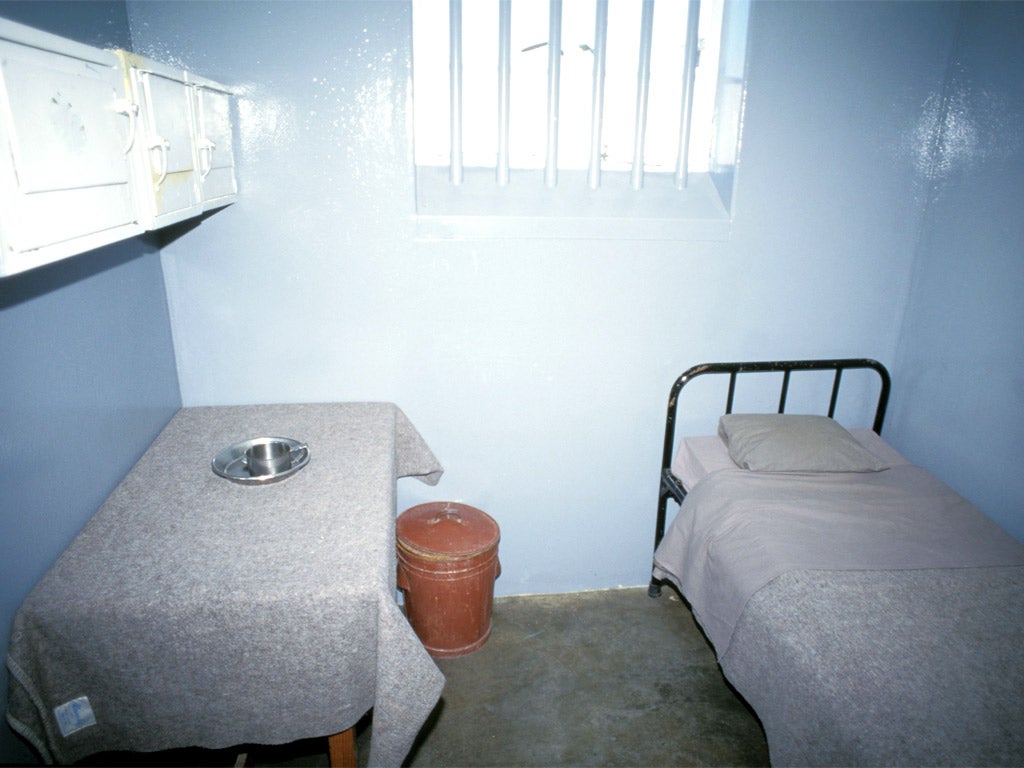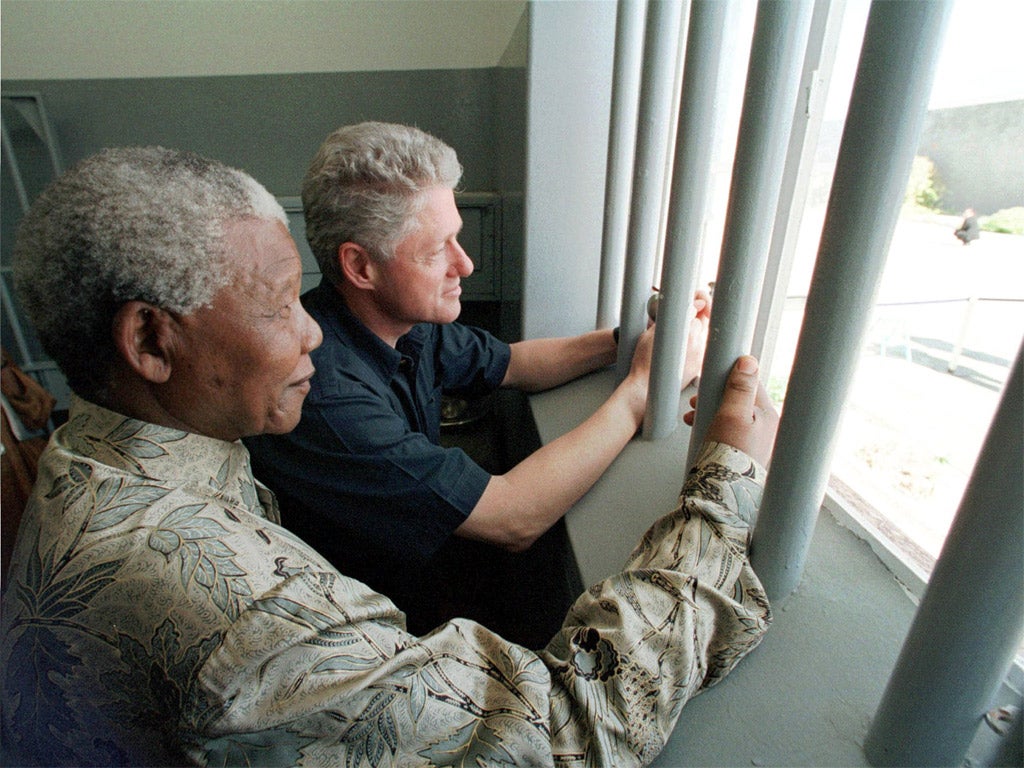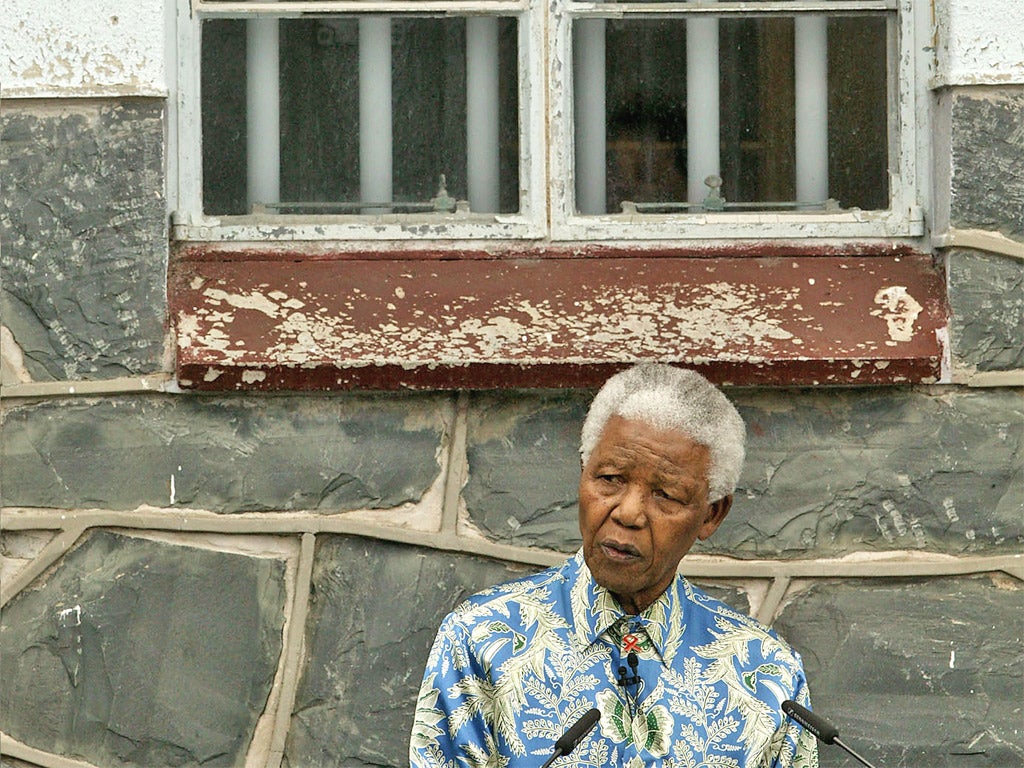Mandela's prison: ‘This is an island. Here you will die’
As the world remembers Mandela the hero, the prison where he spent 27 years seems all the more brutal
The low, scrubby oval of Robben Island, a few miles offshore, can be made out from any of the heights around Cape Town. During the apartheid era, it was a kind of Purgatory in plain sight for those the white regime feared most, a place forbidden to all but the inmates and their jailers.
South Africans called it simply “The Island”, and speculated fearfully as to what went on there. Yet when Nelson Mandela was asked how his 27 years in prison, most of them on Robben Island, had affected him, his answer was unexpected. “I came out mature,” he said.
Mandela disappeared from the world with the reputation of a charismatic but often boastful lawyer, a keen boxer and ladies’ man who did not have the temperament to remain undetected for long when he went underground. He returned a dignified old man who had won the respect of his captors, so much so that they were anxious to negotiate the hand-over of power to him. Thanks to Mandela’s imprisonment there, Robben Island is now a World Heritage Site, but when visitors see the conditions in which he was held, few find it easy to imagine how he retained his sanity, let alone triumphed over his oppression.
Disembarking from their jetfoils after crossing the often turbulent waters of Table Bay, tourists see the same sight that greeted every prisoner on Robben Island: a concrete gateway with the emblem of the apartheid prison service and the motto, “We Serve With Pride”. As they roam the concrete blocks, they are shown the bleak cell, barely 6ft square, where prisoner number 46664 spent years with nothing but a bedroll on the floor, a tiny stool and a ceramic pot.
“Journeying to Robben Island was like going to another country,” Mandela wrote in his autobiography, Long Walk to Freedom. “Its isolation made it not simply another prison, but a world of its own.” He first saw it in May 1963, having been sentenced the previous October to five years for sabotage.

After another trial in Pretoria, this time for treason, he returned to the island in June 1964 and remained there until March 1982, when he was moved to the mainland. He did not walk to freedom until February 1990.
Mandela recalls his first arrival on the island in his book: “We were met by a group of burly white warders shouting [in Afrikaans]: ‘Dis die Eiland! Hier gaan julle vrek!’ (This is the Island! Here you will die!)” Immediately he showed the spirit of resistance that helped to carry him through, telling his fellow inmates to walk when the warders were shouting at them to run, and threatening legal action against one notoriously brutal figure who seemed about to hit him.
While Mandela was never assaulted during his prison term, everything about the regime was designed to punish and humiliate black leaders who had had the temerity to demand equality with whites.
Category D political prisoners like him were allowed one 30-minute visit and one letter every six months. Anything deemed “political” in the letters would be cut out, so that often the prisoner received nothing but a tattered, indecipherable remnant of paper.
Even among inmates there was racial discrimination – Mandela recalled that he and other African prisoners were given shorts to wear, while Ahmed Kathrada, the only Asian among the group of African National Congress leaders who arrived on the island together, received long trousers. Africans also had a worse diet than Asian or mixed-race (the so-called “coloured”) inmates. Removing these inequalities was among the first of many issues on which Mandela and his fellow political prisoners mounted campaigns of passive resistance during their years on Robben Island.

Despite poor food, inadequate clothing in the wet and windswept Cape winter, and heavy labour in the island’s lime quarry, where Mandela’s sight was damaged by the blinding glare of the sun on the quarry’s blanched walls, he remained unbroken. “The challenge for every prisoner, particularly every political prisoner,” he wrote, “is how to survive prison intact, how to emerge from prison undiminished, how to conserve and even replenish one’s beliefs... The authorities’ greatest mistake was to keep us together, for together our determination was reinforced. We supported each other and gained strength from each other.”
The bullying, poorly educated white warders were uncertain how to deal with these articulate, determined political prisoners, who seemed confident that they would one day prevail, no matter how long their sentences or how complete the white regime’s apparent domination. By the early 1970s, Mandela had tamed the prison authorities to the point where they would frequently consult him. Occasional attempts to revert to the old brutal regime were seen off, and concessions, such as the right to study, were won.
But Robben Island remained deeply isolated – isolation worsened, Mandela wrote, by the proximity of “the glass towers of Cape Town. The city looked agonisingly close, as though one could almost reach out and grasp it”. (Rather like Alcatraz in San Francisco, a city to which Cape Town has often been compared for its scenic beauty and hedonistic tendencies, Robben Island served as a constant reminder to those on the mainland of the privations being suffered by some.)
Above all, Nelson Mandela had to fill the endless years without ever knowing how long his imprisonment would last. He had been sentenced to life, and until the late 1980s apartheid’s masters insisted that he would die behind bars.
“To survive in prison,” he wrote, “one must develop ways to take satisfaction in one’s daily life. One can feel fulfilled by washing one’s clothes so that they are particularly clean, by sweeping a corridor so that it is free of dust, by organising one’s cell to conserve as much space as possible. The same pride one takes in more consequential tasks outside prison, one can find in doing small things inside prison.”
Mandela took pains to remain physically fit, and was one of the few who did not complain when the authorities made the prisoners walk to the quarry rather than being taken by truck. He saw it as an opportunity to view the island’s wildlife, much of it descended from animals released for hunting, such as various types of buck, and the swarms of rabbits originally intended to feed passing ships.

South Africa’s future president said he first heard about the island as a child, because a hero of his Xhosa tribe, who led a 19th-century uprising against the British, was incarcerated there. But Robben Island was used as a political prison almost as soon as the Dutch colonised the Cape in 1652. Later it served as a leper colony, a lunatic asylum and as a naval base, where my father was stationed during the Second World War. On his daily trek to the quarry, Mandela would have seen the largest of several naval gun emplacements on the island.
Despite their isolation, the prisoners managed to keep some track of events outside through new arrivals, smuggled newspapers and hints dropped during family visits. “During the harsh days of the early 1970s,” Mandela wrote, “ the ANC seemed to sink into the shadows ... In many ways we had miscalculated; we had thought that by the 1970s we would be living in a democratic, non-racial South Africa.” In 1975, he turned 57, and two of his closest comrades suggested he write his autobiography. It cost him study privileges for four years when part of the manuscript was discovered, but even after it was smuggled out, the ANC in exile decided not to publish it.
The following year, a new generation appeared on Robben Island: militants jailed after the Soweto uprising. “These young men were a different breed,” said Mandela. “They were brave, hostile and aggressive; they would not take orders.” They were almost as sceptical of the older prisoners as of the authorities: after so many years of being branded a radical revolutionary, Mandela found that “to be perceived as a moderate was a novel and not altogether pleasant feeling”. It reinforced the fears of the long-term inmates that “we had become frozen in time”.
This was the greatest challenge of the ANC leader’s years in prison, and Mandela rose to it. He refused the pleas of the prison authorities to intervene with the younger inmates, instead seeking to mediate among the political factions represented on the island. The new prisoners were predominantly supporters of Black Consciousness, which had little respect for the ANC or the rival Pan Africanist Congress, but in time most came under the ANC banner.
The influx also brought unexpected benefits. So busy were the warders with the young firebrands that the older prisoners were practically left to themselves.
In 1977, the political prisoners succeeded in having manual labour halted, giving them more time for reading, studying and political debate. Mandela cultivated his garden and kept fit by playing tennis, the yard of his cell block having been converted into a court.
But those held on Robben Island were still subject to the whim of the authorities, as Mandela discovered in March 1982, when he was abruptly told that he was to be transferred to Pollsmoor prison on the mainland. The reason, it later emerged, was that the apartheid government thought he might prove more pliant in negotiations if he was kept apart from his comrades. They soon discovered they were wrong, but, for Mandela, who had spent the best part of two decades on Robben Island, it was a wrench.
“A man can get used to anything, and I had grown used to Robben Island,” he wrote. “It had become a place where I felt comfortable.” More than that: as he himself said, his ordeal there was the making of him.
Join our commenting forum
Join thought-provoking conversations, follow other Independent readers and see their replies
Comments
Bookmark popover
Removed from bookmarks